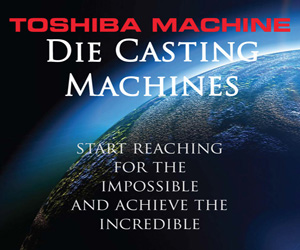The element magnesium (Mg) has a specific gravity of 1.74, making it the lightest commonly used structural metal. When used as a base for die casting alloys, magnesium is alloyed with various combinations of elements from a group including aluminum, zinc, manganese and silicon. Other elements present in the alloys are generally regarded as impurities, and maximum limits (expressed as single numbers) are specified.
The magnesium industry offers several alloys that are widely used for die casting. They are most commonly designated by a system established by ASTM for all magnesium alloys, which covers both chemical compositions and tempers. The first two positions in the ASTM designation are capital letters representing the two major alloying elements, and arranged in decreasing percentages. The letters are followed by numerals indicating the respective percentages rounded off to whole numbers. A letter in the next position indicates a slight variation in composition not reflected in the preceding characters, such as a minor alloying element variation. Temper designations, which normally follow, are not used for die casting alloys because porosity in the die casting, even in relatively small amounts, can cause blistering at heat treating temperatures.
Designations & AZ AM Alloys
The major elements used in magnesium die casting alloys are designated as follows:
A – Aluminum
E – Rare Earth
M – Manganese
S – Silicon
Z – Zinc
Alloy AZ91D, which contains nominally 9% aluminum and 1% zinc, is the workhorse of the magnesium die casting alloys in that it is most often specified. It exhibits an excellent combination of mechanical properties, castability, and corrosion resistance. Corrosion resistance is achieved by enforcing strict limits on three metallic impurities. Iron, copper and nickel are limited to very lower levels making it necessary to use primary magnesium in the production of AZ91D alloy.
Alloys AM60B, AM50A and AM20 are used in applications requiring good elongation, toughness and impact resistance combined with reasonably good strength and excellent corrosion resistance. These properties have made it the choice for components that require toughness and ductility. Ductility increases at the expense of castability and strength, as aluminum content decreases. Therefore, the alloy with the highest aluminum content that will meet the application requirements should be chosen.
Rare Earth Alloys
Alloys AS41B and AE42 are used in applications requiring improved elevated temperature strength and creep resistance combined with excellent ductility and corrosion resistance. These properties make it a good choice for engine and transmission components.
Although magnesium die casting alloys exhibit a number of distinct mechanical properties; they have two in common, deriving from their common magnesium base:
- The tensile and compressive yield strengths for each alloy are substantially equal.
- All of the alloys exhibit the same modulus of elasticity, shear modulus, and Poisons’ ratio.








